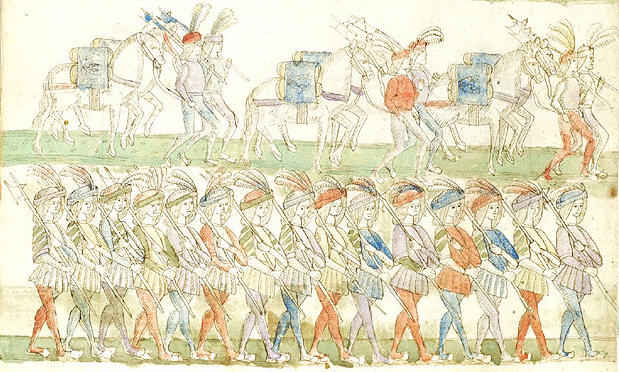Try Amazon Audible Plus

Find the perfect fit with Amazon Prime. Try Before You Buy.
Cronaca della Napoli aragonese (or Cronaca figurata del Quattrocento), by Ferraiolo, after 1498.
French troops and artillery entering Naples, 1495
Folio 109v

Picture source: Pierpont Morgan Library, Ms. 801

A larger image of French troops and artillery entering Naples, 1495.
Picture source: MS M.801 fol. 109v

Picture source: Pierpont Morgan Library, Ms. 801
Manuscript M.801 is a compendium of late medieval chronicles, written and illustrated in Naples, Italy, shortly after ca. 1498. 1) Fasciculus temporum; 2) Cronaca di Partenope; 3) Bagni di Pozzuoli;
4) the unique copy of an untitled continuation (called here Cronaca della Napoli aragonese) which describes events in Naples from 1423-1498.
The author was the son of Francisco Ferraiolo, who witnessed the triumphal entry into Naples of King Alfonso I in 1443.
Cronaca della Napoli aragonese is illustrated with about 120 pen and wash drawings of varying sizes.
These drawings are of considerable interest for their detailed portrayals of contemporary personages and historical events, as well as Neapolitan life, costume and landscape.
Decoration: ca. 150 pen and ink drawings, tinted with colored wash, and numerous diagrams.
The illumination of M.801 is unfinished. Between fols. 128r and 145v, spaces were left for 53 drawings that were never executed.
Contents: fols. 1r-51v: Werner Rolevinck, Fasciculus temporum -- fols. 52r-83r: Cronaca di Partenope -- fols. 85r-88r: Bagni di Pozzuoli -- fols. 84r-150r: Ferraiolo, Cronaca della Napoli aragonese.
Language: Italian (Neapolitan dialect) and Latin
Script: humanistic script
History: Written at Naples, South Italy, some time after 1498, the last date included in the Chronicle.
Call Number: B1 361 D MS M.0801
Folio 109v
Cronaca della Napoli Aragonese: Scene, French entering Naples -- Continues parade of previous folios in four registers:
1) Woman (?) wearing headdress possibly sitting sideways; eight men, wearing plumed hats, one, wearing sword at waist, astride horse; one carrying halberd, wearing sword at waist; two wearing swords at waists, one carrying banner; one playing drum; the foremost, wearing sword at waist, playing cornetto.
2) Three two-wheeled carts, drawn by three (?) horses, four men wearing hats possibly astride the horses. One cart carries sacks inscribed SACHE DE FARINA; second cart inscribed PALLE DE FIERRO. At right, three cannons on two-wheeled carts, inscribed ARTEGLIARA, drawn by three (?) horses, four men wearing hats possibly astride the horses.
3) Three pairs of bridled, pack-horses, each led by man wearing plumed hat, grasping reins with right hand, carrying halberd on left shoulder.
4) At bottom, line of 15 men wearing plumed hats, each carrying halberd on right shoulder, walking to right.
Pierpont Morgan Library, Ms. 801
See also A 1506 print of the Battle of Fornovo, Italy, 1495
French Soldiers in Le Voyage de Gênes (The Journey to Genoa) by Jean Marot, 1510-1520
15th Century Illustrations of Costume & Soldiers



